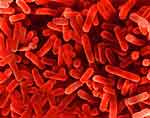

 |
What is the Legionella bacteria? It is a group of bacteria widely spread in nature which need a damp atmosphere and heat (between 32ºC and 45ºC) to live and grow. Its natural habitat is water: rivers, lakes, streams and thermal water. It can also be found in contaminated artificial environments, such as humidifiers, cooling towers, drinkable water supplies, etc. |
What type of infections does it produce? The legionella bacteria usually causes two types of infections, both regularly caused by the pneumophile, serogroup 1. These two diseases are: 1.- Pontiac’s fever: this type is less serious and the most frequent, it resembles a flu, it does not cause pneumonia, it is self limited, it progresses positively and the full recovery occurs within a week. 2.- Legionnaire’s disease: it was described for the first time in 1947 and the first outburst appeared in 1965 in a psychiatric hospital in Washington, U.S.A. It was named like that because it affected the participants in an American Legion meeting at Philadelphia in 1976. This disease causes a pneumonia and it affects the general well-being. It is the most serious form. The majority of the cases appear sporadically (over 80% of the cases), and the epidemic outbreaks are a lot less frequent. |
What are the symptoms of the legionnaire’s disease?
|
Who are at risk? Although anyone can contract the disease, it preferably affects people who have a higher risk of contracting an infection by the legionella bacteria. They are elderly people or people with weakening illnesses ( people with heart, lung, kidney or diabetes conditions, etc), smokers with a low immune system or being treated with immune suppressant drugs (they diminish the defences). Children are at little risk, although it is less frequent to contract the disease at that age. It even goes unnoticed. There are very few registered cases of serious infections in children. |
How is the disease contracted? The most known theory is that the way to get infected is via water drop aerosols which contain the legionella bacteria and are inhaled by the person. These drops come from reservoirs infected with the legionella bacteria, these could be refrigeration equipments, humidifiers, showers, sprinklers, ornamental fountains, etc.Nevertheless, there is new evidence that suggests a different more common way of getting infected. “Aspiration” is the easiest way for the bacteria to enter the lungs and causing pneumonia. Aspiration is produced when, due to choking, the mouth secretions go wrongly into the lungs instead of going towards the oesophagus and stomach. The mechanism to protect against the “Aspiration” does not function in patients who smoke or who have lung illnesses. |
| How can the legionella bacteria be prevented in the Cooling Towers? In order to prevent the proliferation of the legionella bacteria in the Cooling Towers, it is necessary to take the following measures: * Regular cleaning and maintenance. * Water treatment. * Suitable SANIPACKING® components. |
Most of the nutrients for the bacteria are eliminated through cleaning and maintenance, besides, the disinfectants are more effective. The treatment of the water helps to keep the circuit free of incrustations that could lead to oxidation and sediments, therefore, nutrients for the bacteria, then, the circuit water and mainly the water in the basin are treated by adding some type of biocide. Finally, by using the SANIPACKING® filling and drift eliminator we make sure that no reservoirs of bacteria appear on the surface of the panels. Keeping in mind that this is the biggest contact surface of the cooling tower and it is inaccessible, it is very important since had it not been treated, the whole circuit could become contaminated, even soon after cleaning and disinfection of the equipment. |